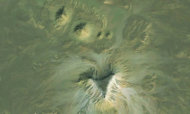See other Science/Tech Articles
Title: Long-lost Egyptian Pyramids Found on Google Earth?
Source:
Yahoo
URL Source: http://news.yahoo.com/long-lost-egy ... nd-google-earth-005252340.html
Published: Aug 14, 2012
Author: Natalie Wolchover
Post Date: 2012-08-14 09:30:06 by Original_Intent
Keywords: archaeology, pyramids, knowledge, filter
Views: 274
Comments: 4
A self-described "satellite archaeology researcher" has garnered widespread media attention with claims that she has found two possible pyramid complexes in Egypt using Google Earth. But experts say her pyramids are nothing more than eroded hills infused with a heavy dose of wishful thinking. Are these Egyptian desert features … Angela Micol, a North Carolina-based woman who blogs at Google Earth Anomalies, says she discovered the two clusters of mysterious, angular mounds in the Egyptian desert while surveying satellite images of the terrain using Google Earth, the virtual map program. In its coverage, Gizmodo asserts that the desert structures look as if they have been "very deliberately arranged," and that they "bear all the hallmarks of ancient pyramid sites." If Micol's blog is to be believed, Egyptologists have vetted and are currently investigating her amazing discovery. "The images speak for themselves. It's very obvious what the sites may contain but field research is needed to verify they are, in fact, pyramids," Micol wrote on her blog. Turns out, further field research won't be necessary after all. These mounds are just your common buttes. "It seems that Angela Micol is one of the so-called 'pyridiots' who see pyramids everywhere," said James Harrell, professor emeritus of archaeological geology at the University of Toledo and a leading expert on the archaeological geology of ancient Egypt. "Her Dimai and Abu Sidhum 'pyramids' are examples of natural rock formations that might be mistaken for archaeological features provided one is unburdened by any knowledge of archaeology or geology. In other words, her pyramids are just wishful thinking by an ignorant observer with an overactive imagination." [How Much Would It Cost to Build the Great Pyramid Today?] (Micol did not respond to an email from Life's Little Mysteries as of the time of publication.) The large, three- and four-sided hills Micol chanced upon are geologic features known as buttes, Harrell told Life's Little Mysteries. Commonly seen in the local Faiyum Desert, such buttes form when a mound of sediment contains a difficult-to-erode layer. When the surrounding sediment gradually erodes, that resistant layer gets left on top, making the hill flat. Meanwhile, the smaller hills found in Micol's Google Earth screenshots are circular, and thus nothing like pyramids, Harrell said. Other geologists attribute the features to the forces of nature as well. "What it looks like to me is an area where a resistant layer of stone is underlain by soft rock, perhaps shales. If that is so, the triangular one looks very much the sort of feature common in the U.S. southwest, and might be called a butte," said Clair Ossian, a geoarcheologist at Tarrant County College who has studied Egypt's sites. So in summary, sorry folks: nothing to see here but a couple of big buttes. The question is how they garnered so much breathless, and factless, media attention. Poster Comment: Of course the mainstream denies anything that does not fit the existing template. So, decide for yourself based on evidence and not on the scribblings of a writer who is required to follow the lamestream. If legitimate, and they do look artificial, this would not be the first time the lamestream has buried, and ignored, evidence that does not fit the lamestream narrative.
Post Comment Private Reply Ignore Thread
Top • Page Up • Full Thread • Page Down • Bottom/Latest
Begin Trace Mode for Comment # 4.
#3. To: Original_Intent (#0)
ON a more on topic note What is described there... describes the foundation of the pyramids....
What caught my eye was the regular shape with right angled corners. As Michael Cremo, co-author of "Forbidden Archaeology", has pointed out repeatedly there is a knowledge filter at play in lamestream archaeology which filters out any anomaly that is outside of their carved in stone theories. Doubly so if it would conflict with the world according to St. Darwin.
There are no replies to Comment # 4. End Trace Mode for Comment # 4.
Top • Page Up • Full Thread • Page Down • Bottom/LatestWhat it looks like to me is an area where a resistant layer of stone is underlain by soft rock, perhaps shales.
#4. To: titorite (#3)
Replies to Comment # 4.
